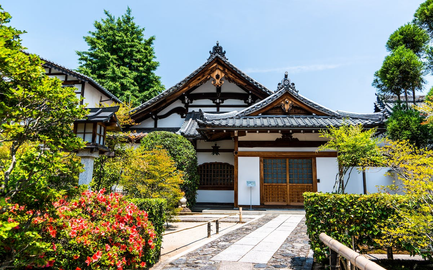
Apply to a foreign university with confidence
- Properly fulfilled documents
- Perfect motivation letter
- Support from a personal mentor
- Offers from several universities
What are the features of Italian higher education? Let’s discuss all the advantages and disadvantages of studying there, how much does it cost for a foreigner and why Italy is the number one destination for the Erasmus exchange program.
Free consultation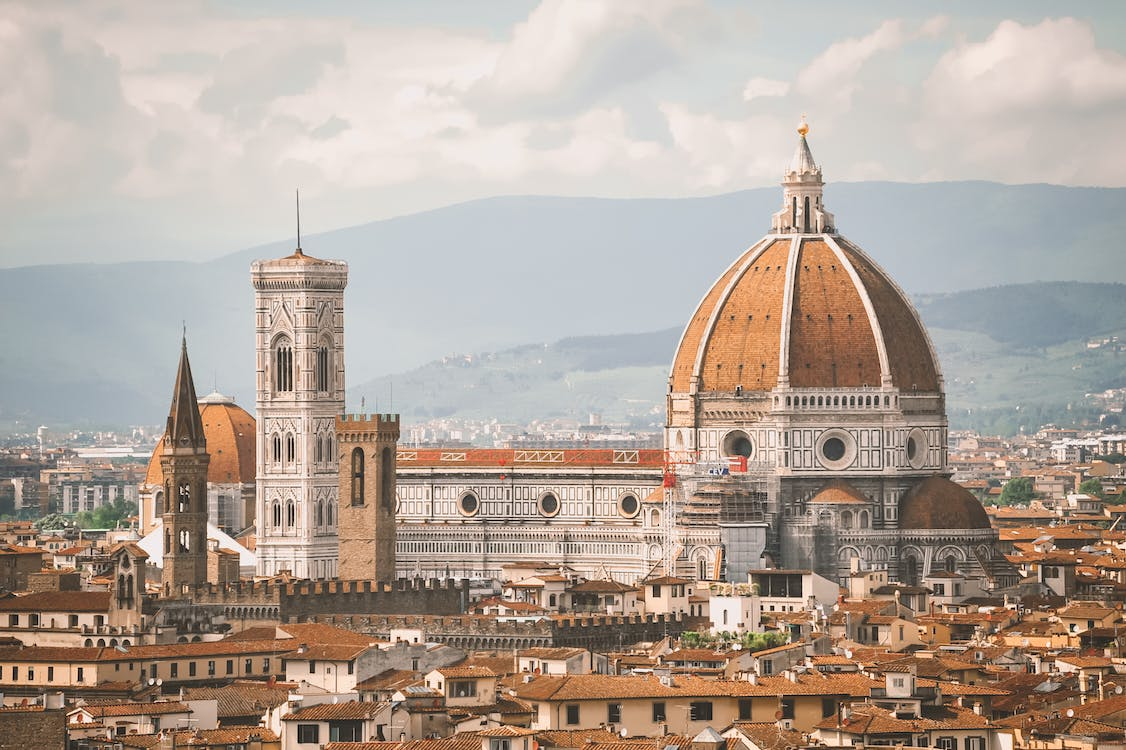
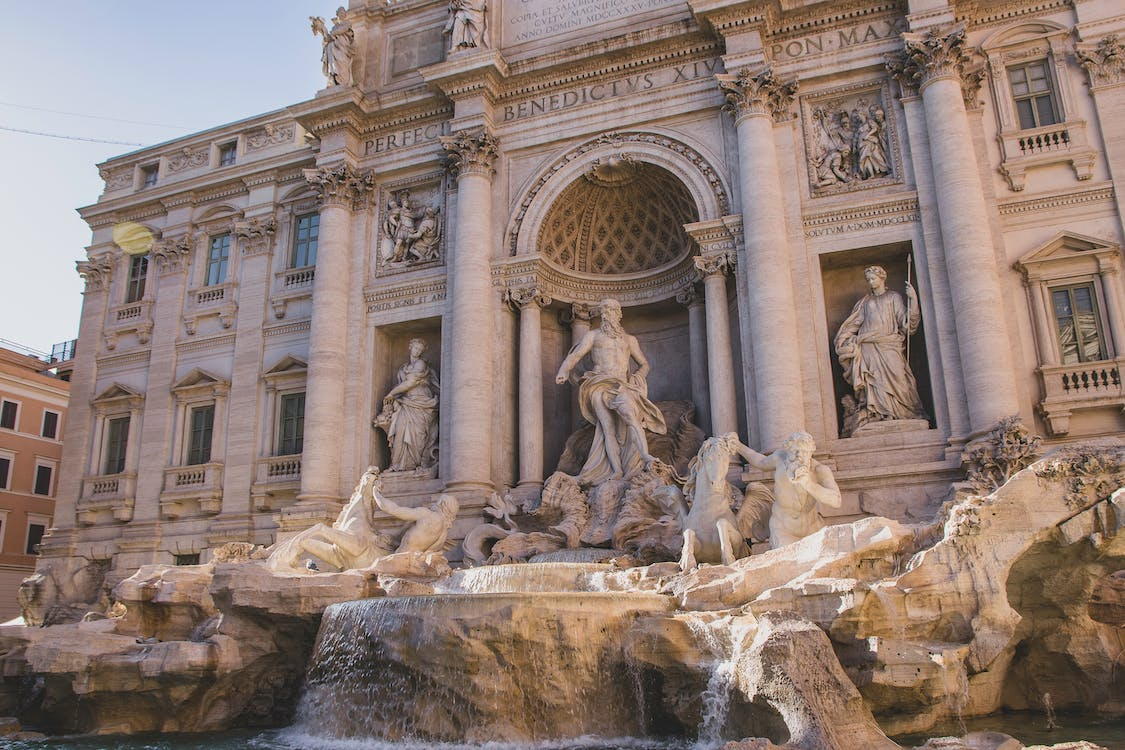
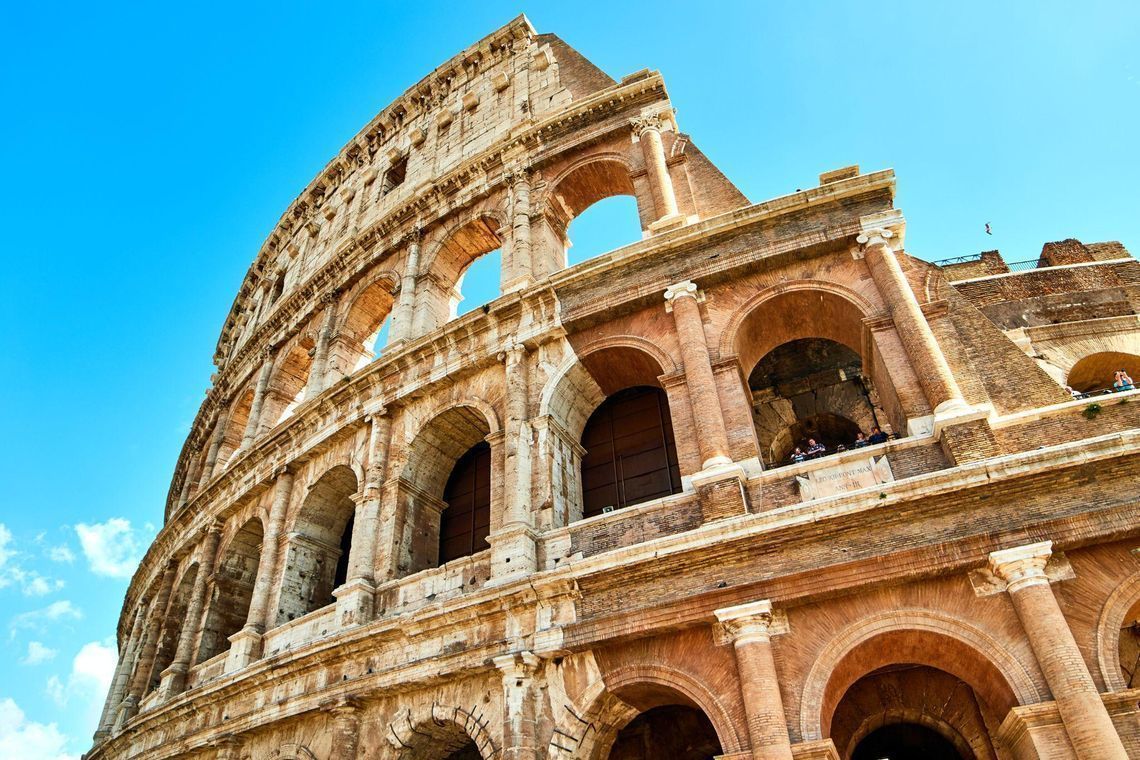

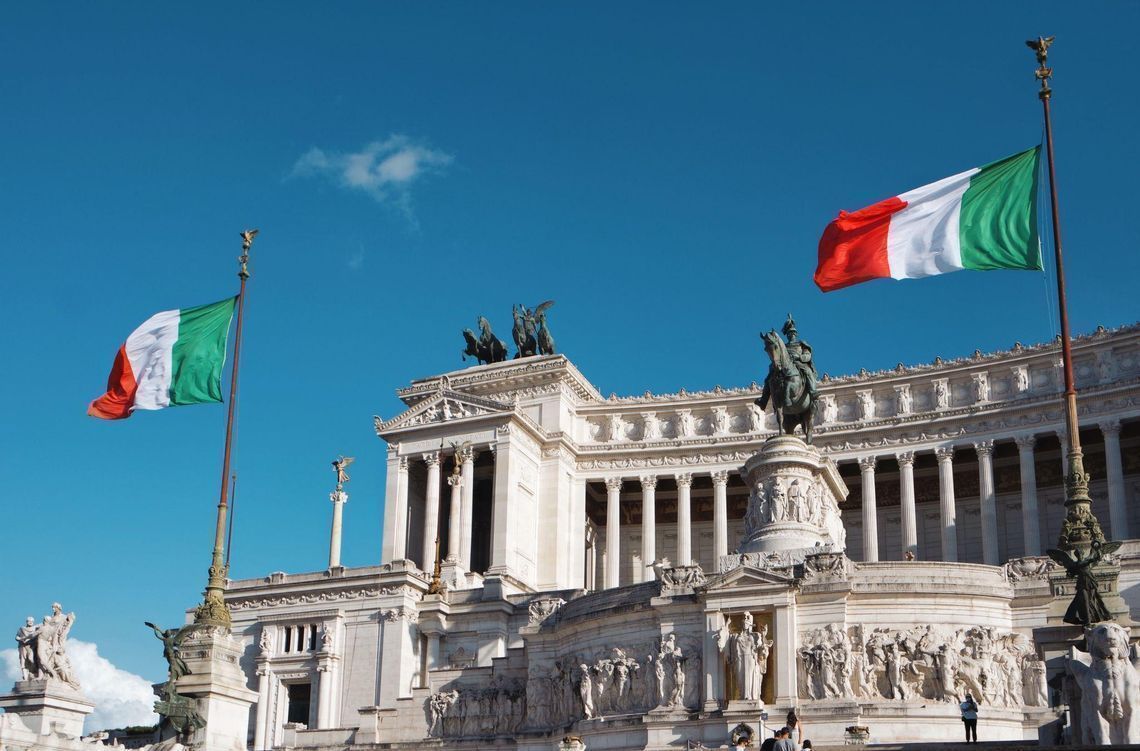

Secondary education in Italy is divided into two stages:
Scuola secondaria di primo grado is a secondary school, compulsory for all children between the ages of 11 to 14. All educational institutions adhere to the general curriculum, which includes the Italian language and literature, history, geography, mathematics, natural science, computer science, English and an additional foreign language (usually French or Spanish), art, music and physical education.
At the end of the third year of schooling, children have to take five written and one oral exam in completed subjects. In case of success, a special diploma is issued, indicating the completion of this stage of training, — diploma di licenza media.
Scuola secondaria di secondo grado is a five-year high school for students aged 14 to 19. The first two years of education (until children reach the age of 16) are compulsory, the remaining three are not. Students can choose which educational institution they want to attend at this stage:
At the end of the fifth year of study, all students pass the final exam (esame di Stato), qualifying them for university admission.
Education in Italy annually attracts thousands of foreign students from all over the world. Italy is considered the most popular destination under the international exchange program Erasmus. It is worth going there not only for delicious food and rowdy entertainment. Italy is the birthplace of the most iconic Renaissance artists, so to no one's surprise, the university buildings look like the works of art as well. The very first university in Europe was built here — the history of the University of Bologna can be traced back to the Crusades of the 11th century.
| Program | Min. age | Duration | Min. cost | Avg. cost | Min. language level | Exams |
|---|---|---|---|---|---|---|
| Summer Camp | 7+ | 1–12 weeks | 791 USD/week | 1,469 USD/week | A1 | - |
| Language School | 16+ | 1–12 weeks | 169 USD/week | 305 USD/week | A1 | - |
| Secondary education | 11+ | 5-9 years | Free (Public school) | 16,950 USD (Private) | B1 | - |
Foundation | 16+ | 1 year | 4,181 USD/year | 5,650 USD/year | A1 | CILS |
| College | 16+ | 1-3 years | 1,356 USD/year | 4,294 USD/year | B1 | IELTS / CILS |
| Bachelor’s | 17+ | 3 years | 1,921 USD/year | 4,520 USD/year | B2 | IELTS / CILS |
| MBA | 20+ | 2 years | 9,040 USD/year | 28,250 USD/year | B2 | IELTS / CILS |
| Master’s | 20+ | 1-2 years | 5,650 USD/year | 7,910 USD/year | B2 | IELTS / CILS |
| Doctoral | 20+ | 3-5 years | 960 USD/year | 1,130 USD/year | C1 | IELTS / CILS |
Italian higher education system includes several types of institutions:
| Expenses | Average cost |
|---|---|
| Exams | 79 USD |
| Registration fee | 86 USD |
| Flight | 181 USD |
| Rent | 565 USD/month |
| Meals | 508 USD/month |
| Insurance | 169 USD/year |
| Learning materials | 56 USD |
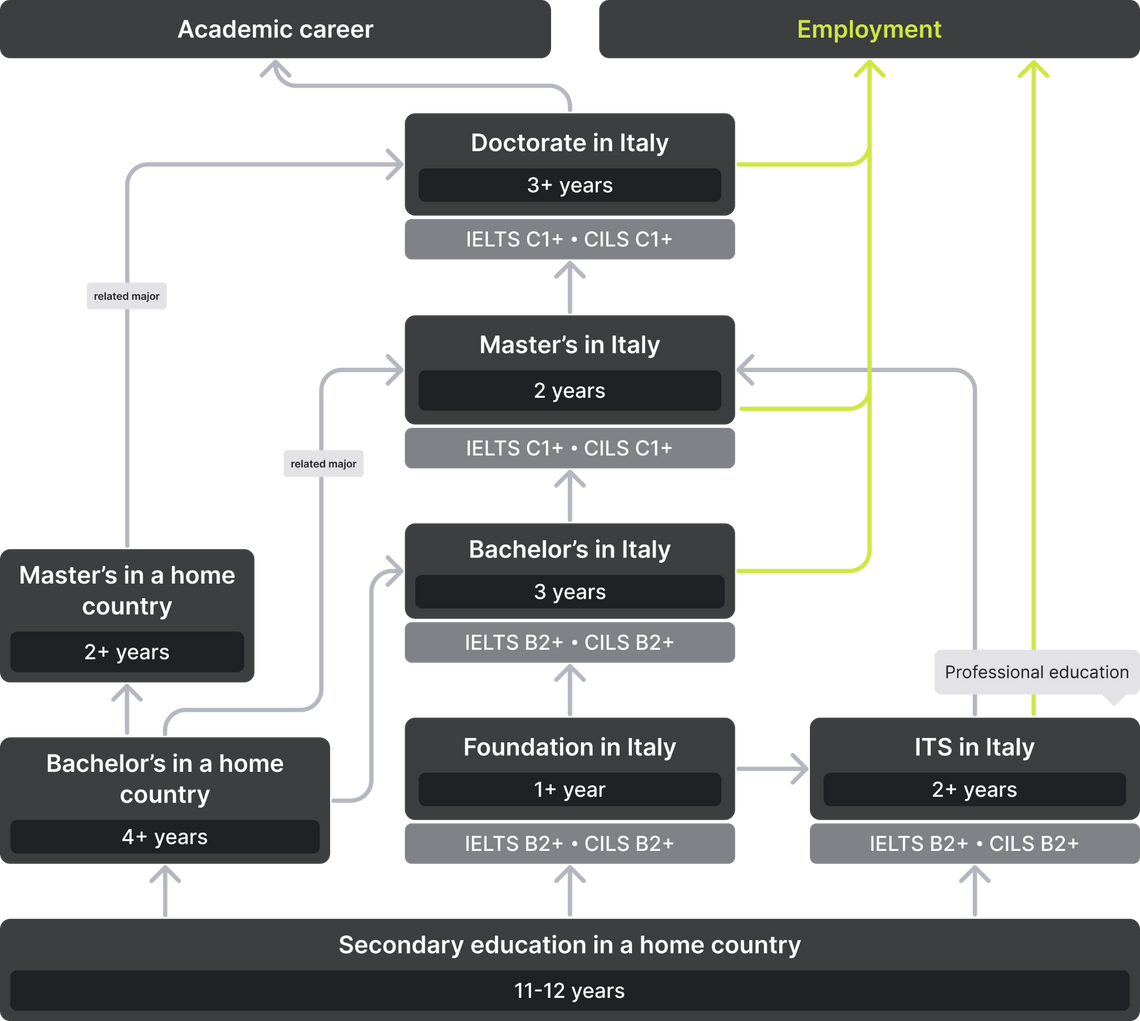
In order to enter Italian university, one must complete 12 years of secondary school. If this requirement is not met, there are several options:
The Foundation courses (corsi propedeutici) are designed specifically for international students to help them bridge the gap between the educational system in Italy and the home country of the applicant, as well as successfully pass the entrance exams before entering the university. The main advantage of such courses, in addition to preparing for studies in Italy, is the fact that many universities allow graduates of their preparatory programs to forgo entrance examinations.
The curriculum usually consists of classes in Italian and/or English, as well as subjects in the chosen direction.
Applicants may also be asked to take an additional interview on Skype to assess the level of language proficiency.
Please note that art schools often have much higher requirements for student selection, including possible age limits. In addition, preparatory programs here can last up to three years.
At the end of the training, students pass the final exam and receive a certificate of completion.
Vocational education in Italy is represented by Higher technical institutes (Istituti Tecnici Superiori, ITS) and Higher technical training and education (Istruzione e Formazione Tecnica Superiore, IFTS).
Bachelor’s degree (Laurea), according to the Bologna process adopted by Italy, is the first stage of higher education.
There are two types of programs at Italian universities: limited and unlimited (open).
Laurea studies last for three years (180 ECTS), during which students must learn about basic scientific concepts and research methods. The curriculum consists of theoretical studies, seminars, lectures, as well as work on their own research paper — the graduation thesis.
Students from EU-countries can apply directly to the chosen higher institutions according to the terms and the requested documentation. In contrast, submission of documents for other international students begins with the so-called "pre-enrolment"[4]. For this, applicants must fill out a questionnaire in Italian or English and deliver it along with other documents to the Italian Consulate. Please note that you may choose only one university and only one program for admission.
After that, the Italian embassy will send documents to the university, which will set the deadlines for entrance examinations and decide on the admission status of a student. The next steps include applying for a visa, a trip to Italy to take additional exams and the final decision of the university to enrol (or not enrol) an applicant.
Master’s (Laurea Magistrale) in Italy lasts two years (120 ECTS) or four semesters with summer break in the middle. Students attend basic courses, electives, lectures, and workshops, perform individual and group work. The last academic semester is devoted exclusively to writing a dissertation that should be 100 or more pages long.
Documents required for "pre-enrolment":
Documents requested by universities:
An important condition for admission is the conformity of the specialization of the completed undergraduate to the chosen field of master’s degree.
Some areas may require additional exams: for example, for admission to the Polytechnic Institute of Milan (Politecnico di Milano) to the Energy Engineering and Management Engineering programs, it is strongly recommended to pass GRE.
Laurea magistrale a ciclo (Which can’t be considered either bachelor’s or master’s degree) in such areas as medicine, law, engineering, and architecture are equivalent to a master's program, but they last five to six years (300 or 360 ECTS) and do not require bachelor’s degree for admission.
Laurea Magistrale in Italy should be distinguished from Master, which is not a master’s degree, but one-year diploma. Master of the first level can be obtained after Laurea (bachelor’s), and the second level — after Laurea magistrale (master’s). By themselves, they do not replace academic degrees, but together with them, they can facilitate admission into the next stages.
Doctoral studies (Dottorato di Ricerca) is the third level of higher education. Thus, the admission to such programs requires a Master’s degree in the same or related area. Training lasts from 3 to 5 years. The first year is devoted to classes, and the subsequent years are reserved for the student’s own research. In addition, the student may be assigned the duties of a teacher (up to 40 hours per year).
Both European and non-European students submit documents directly to the university without undergoing the "pre-enrolment" procedure.
The average salary of a ricercatore is 1,695 USD/month, associate professor — 2,825 USD/month, and professor — 4,068 USD/month.
It is quite difficult for foreigners to get into the academic environment due to the existing language barrier, since most university programs are currently taught in Italian. Nevertheless, universities are gradually starting to open to employees from other countries, even despite the need to learn a language and relatively low wages in the initial stages of a career. It is worth noting that many private universities and faculties of economics in public universities are hiring foreign applicants more willingly.
In Italy, there is a large selection of scholarships and grants available to international students:
Citizens of EU and EFTA countries can enter Italy with a valid national identity card or passport. The only procedure they have to follow is registering at the local Ufficio Anagrafe (registry office of the Municipality) upon arrival.
Other non-EU students are required to obtain a long-stay visa to study in Italy for a period of more than 90 days.
List of documents for a student visa to Italy:
The visa fees and the complete list of documents vary depending on the country of citizenship. You can check details here. Within 8 days upon arrival, non-EU students must apply for a permit to stay (Permesso di Soggiorno) at the local post office and pay a fee of 114 USD.
According to Italian law, students from EU countries have the same rights to work in Italy as Italian nationals, including full-time employment all year round. Other foreign students with a permit to stay (Permesso di Soggiorno) can work no more than 20 hours a week and 4 hours a day. A mandatory requirement when applying for a job is knowledge of Italian at a high level.
In search of work, students can go to employment centres or seek the help of student employment departments at the university. Most internships are free, but some companies pay students from 500 to 1,130 USD/month.
Non-EU graduates of Italian universities have the right to stay in the country for one year in order to seek employment. After successful employment, foreigners receive a permanent residence permit in Italy for the purpose of work (Nulla Osta al lavoro). Please note that the number of work permits is limited by quotas: in 2019, the immigration service had the right to issue no more than 30,850 of such documents[5].
You can apply for citizenship after 10 consecutive years of residing in Italy.
60+ countries
we work with
$1,000,000 saved
by students through scholarships
6,400 offers
our students got